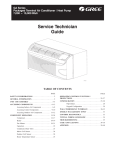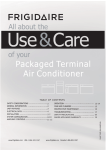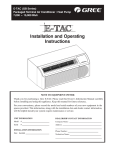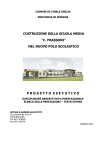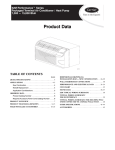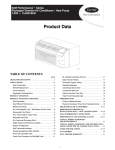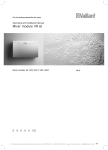Download PremAire PTW153C3G Owner`s manual
Transcript
Packaged Terminal Air Conditioner/Heat Pump
7,000---15,000Btu/h
C
Packaged Terminal
Air Conditioner
GREE 6616 0003 V1.0
OWNER'S MANUAL
PremAire AIR CONDITIONERS
MODELS:
PTW072C3G
PTW122C3G
PTW073C3G
PTW123C3G
PTW072H3G
PTW122H3G
PTW073H3G
PTW123H3G
PTW092C3G
PTW152C3G
PTW093C3G
PTW153C3G
PTW092H3G
PTW152H3G
PTW093H3G
PTW153H3G
GREE ELECTRIC APPLIANCES,I NC.OF ZHUHAI
Thank you for choosing PremAire air conditioner for correct operation, please
read this owner's manual carefully before operating the unit and keep
it carefully for consultation.
CONTENTS
■ SAFETY CONSIDERATIONS ...........................1
■ GENERAL INFORMATION ............................1
■ UNIT FEATURES ................................... 2
■ ELECTRICAL DATA ................................. 4
■ INSTALLATION .....................................5
■ HOW TO CONNECT ................................. 8
■ SYSTEM CONFIGURATION ........................... 9
■ AUXILIARYCONTROLS ..............................12
■ OPERATION .......................................14
■ CARE AND CLEANING ...............................15
■ PREVENTATIVE MAINTENANCE .......................16
■ TROUBLESHOOTING ...............................17
The figures in this manual may be different with the material objects, please refer
to the material objects for reference.
This symbol stands for the items
should be forbidden
This symbol stands for the items
should be followed
Do not dispose this product as unsorted municipal waste.
Collection of such waste separately for special treatment
is necessary.
SAFETY CONSIDERATIONS
Recognize safety information. This is the safety--alert symbol . When you see this symbol on the unit and
in instructions or manuals, be alert to the potential for personal injury.
Understand these signal words: DANGER, WARNING, and CAUTION. These words are used with the
safety--alert symbol. DANGER identifies the most serious hazards which will result in severe personal
injury or death. WARNING signifies hazards which could result in personal injury or death.
CAUTION is used to identify unsafe practices which may result in minor personal injury or product and
property damage. NOTE is used to highlight suggestions which will result in enhanced installation,
reliability, or operation.
!
WARNING
PERSONAL INJURY AND/OR PROPERTY DAMAGE HAZARD
Failure to follow this warning could result in personal injury, death and/.or property damage.
For your safety, the information in this manual must be followed to minimize the risk of fire or explosion, electric
shock, or to prevent property damage, personal injury, or loss of life.
S This unit must be properly installed in accordance with the Installation Instructions before it is used.
S Immediately repair or replace all electric service cords that have become frayed or otherwise damaged.
S Unplug or disconnect the unit at the fuse box or circuit breaker before making any repairs.
NOTE: We strongly recommend that any servicing be performed by a qualified individual.
GENERAL INFORMATION
PremAire package terminal air conditioners and heat pumps provide a high standard of quality in performance,
workmanship, durability and appearance as they heat and cool the occupied air space year round.
This manual provides information for ease of installation, operation and maintenance.
All models are designed for through--the--wall installation. Separate installation instructions are
included with all accessory components.
BEFORE YOU BEGIN
Read these instructions completely and carefully.
IMPORTANT: Save these instructions for local inspector’s use.
IMPORTANT: Observe all governing codes and ordinances.
NOTE TO INSTALLER
Be sure to leave these instructions with the owner.
NOTE TO OWNER
Keep these instructions for future reference. Be sure to write down the model and serial number of unit on
space provided on back page. The model and serial number can be located on the serial number plate
attached to unit. These numbers are required for service. (See Fig. 1.)
Fig. 1 – Sample Data Information Plate
1
UNIT FEATURES
This Premium Premaire unit has many exciting features which
are different than those found on standard PTAC
models. The owner must be familiar with these
features in order to fully understand the operation and
capability of the unit.
• Intelligence – Your Premium Premaire unit has an on board
computer that utilizes real time diagnostics to prolong
the life of your unit. There is an LED indicator on the
control board, behind the front panel, that will flash
an error code if the unit has detected some kind of
fault condition. In many cases, the unit will
Fig. 2
automatically clear the fault condition and continue
operating with no interruption. In some cases, the
condition cannot be cleared and the unit will require service. In those cases, an “Fx” failure mode will be
displayed on the digital display. For a detailed list of all error codes and “Fx” conditions, see Table 6 -Status LED Indicator Definitions for further details.
• Memory – Your Premium Premaire unit also has memory. If power is lost, all of the control settings (setpoint,
mode, fan speed, on/off and configuration) are remembered. So when power is restored, the unit will
start back up in the mode (and configuration) it was in, when power was lost.
• Premium Sound – The unit not only does it have2 fan motors and a tangential blower wheel for
optimum sound, the indoor fan will always run a minimum of 10 seconds before the compressor, to
help reduce any compressor starting noise.
• Random Compressor restart -- To help prevent power surges after a power outage (from many of
your PTACs starting at the same time), the compressor is equipped with a 2:45 to 3:15 random
restart delay feature. Whenever the unit is plugged in, or power has been restarted, a random compressor
restart will occur.
• Compressor Protection -- To prevent short cycling of the compressor and maximize it’s life, there is a
random start--up delay of 3 minutes on the compressor and a minimum compressor run time of 3 minutes.
• Automatic room freeze protection – automatically will keep the temperature in the room from getting
too cold, where water pipes might freeze. If the unit is configured for the freeze protection feature to be
active (which is the default condition), then whenever power is supplied to the unit, if the unit senses
temperature below 40°F, the fan motor and electric heater are turned on and will warm the room to 50_F.
If Freeze protection is not required, change the configuration switch to turn the feature off (see
section on unit configuration).
• Automatic defrost protection (for heat pump models only) – When the outdoor temperature gets
too cold (approx. 35°F) and the unit can no longer effectively heat with the compressor, the unit will
automatically switch to electric heating. The unit will then heat with electric heat until the outside
temperature rises enough (approx. 40°F), so the compressor can be used again.
• Automatic Quick Warm--up (for heat pump models only) -- If the room temperature falls to 5°F
below the set point temperature, the reverse cycle heat is shut off and the electric strip heat is turned on
for one cycle, until heating is satisfied.
•LED Indicator’s and Buttons -- The touch pad has buttons for MODE, FANSPEED, ON/OFF,
SETPOINT UP and SETPOINT DOWN. It also has LEDs that correspond to the mode, fan speed and
setpoint operation, to indicate the unit’s status. The LEDs below the mode button, FAN, COOL, and
HEAT, indicate what operating mode is active. The LEDs below the Fan button, Low, Med and Hi,
indicate the fan speed that is selected. The LED located in the lower right corner is the unit On/Off
status LED. If the unit is in ON mode, the LED will be green. If the unit is OFF, the LED will be red.
• Configure Fan to Optimize Selected Application -- Unit can be optimized to selected application by
configuring the fan to run in continuous mode or cycle on and off with the compressor and electric
heater (can be different for both heating and cooling modes). In cycle mode, fan will continue to run after
compressor or electric heater stops in order blow off any residual heat or cool left on coil.
2
UNIT FEATURES CONTINUED
• Unit Configuration – There are many different configuration possibilities, through both dipswitches
and the digital keypad, that allow you to configure the unit for your exact application. See section on
unit configuration for more details. Following are the configuration selections that have not previously been
mentioned:
• _F or _C – The unit can display in either _F or _C
• Indoor Temperature Sensor Biasing – Optimize the room temperature sensor reading to your exact
application (one for cooling and another for heating)..
• Emergency Heat (for Heat Pump Only) – Disable the compressor during heating mode operation (heat
only with Electric Heat).
• Display Setpoint OR Room Temperature -- The unit can be configured to display the room
temperature OR setpoint only, during heating and cooling modes. See section on unit configuration for
more details.
• Limit the Setpoint Range -- The unit can be configured to limit the controlling setpoint range. The
display will always show the complete setpoint range, but the controlling setpoint will be limited to the
configured minimum and maximum setpointselected. See section on unit configuration for more details.
• Energy Management – Sometimes known as Front Desk Control, an input is provided so that the
unit can be manually disabled from a different location. If the unit detects 24vac on this input, it will
automatically turn itself off. If no voltage is detected on the input, the unit will run normally.
• Wall Thermostat Control – A wired wall thermostat can be connected to the unit. If it is, the
unit must be configured to disable the keypad. See section on wired inputs and unit configuration for
more details.
3
ELECTRICAL DATA
WARNING
!
ELECTRICAL SHOCK HAZARD
Failure to follow this warning could result in personal injury or death and/or property damage
DO NOT alter cord or plug or use an extension cord.
POWER CONNECTION OPTIONS
Appropriate power cord accessory kit is determined by the voltage, and amperage of the branch circuit.
The unit does not come with a power cord (or hard wire kit). An accessory power cord kit must
be ordered to connect the unit to the outlet. If the unit is to be hard wired, an accessory hard wire kit
must be ordered.
IMPORTANT: For 265V units, if power cord accessory option is selected, the cord is only 18”
long and must plug into the accessory electrical 265V subbase.
Be sure that your outlet matches the appropriate blade configuration of the plug and that it is within reach of
the service cord.
All wiring, including installation of the receptacle, must be in accordance with the NEC and local codes,
ordinances and regulations. National codes require the use of an arc fault or leakage current detection
device on all 208/230V power cords. Be sure to select the correct cord for your installation.
ALL UNITS
Wire Size
Use recommended wire size given in Table 1 and install a single branch circuit. All wiring must comply
with local and national codes. All units are designed to operate off ONE single branch circuits only.
NOTE: Use copper conductors only.
Table 1—SUGGESTED BRANCH CIRCUIT WIRE SIZES*
NAMEPLATE AMPS
AWG WIRE SIZE{
7.0 to 12
14
12.1 to 16
12
16.1 to 24
10
LEGEND
AWG --- American Wire Gauge
* Single circuit from main box.
{ Based on copper wire at 60_C temperature rating.
Grounding
For safety and protection, the unit is grounded through the service cord plug or through separate ground
wire provided on hard wired units. Be sure that the branch circuit or general purpose outlet is grounded.
VOLTAGE SUPPLY
Check voltage supply at outlet. For satisfactory results, the voltage range must always be within the
ranges found on the data information plate.
Cord--connected Units
The 250--v field supplied outlet must match the plug for the standard 208/230--v units and be within reach
of the service cord. The standard cord--connected 265--v units require an accessory electrical subbase
for operation. Refer to Table 2 for proper receptacle and fuse type.
Power Cord Protection
The power cord for 230/208v units provide power cord fire protection. Unit power automatically
disconnects when unsafe conditions are detected. Power to the unit can be restored by pressing the reset
button on plug head.
Upon completion of unit installation for 230/208V models, an operational check should be performed
using the TEST/RESET buttons on the plug head.
NOTE: The 265v models do not incorporate this feature as they require use of the electrical subbase accessory.
Table 2—RECEPTACLES AND FUSE TYPES -- 250, 265 VOLTS
RECEPTACLE
AMPS
RATED VOLTS
TIME ---DELAY TYPE FUSE
(or HACR Circuit Breaker)
15
250
20
250
30
250
15
265
20
265
30
265
15
20*
30
15
20
30
LEGEND
HACR --- Heating, Air Conditioning, Refrigeration
* May be used fro 15 ---amp applications
4
INSTALLATION
Proper installation is the responsibility of the installer.
Product failure due to improper installation is not covered under the Warranty.
CHASSIS INSTALLATION
Units are shipped without a sleeve. In applications where unit is a replacement, it is recommended that a
approved PTAC sleeve.
These units can retrofit General Electric, Amana, Trane, and Friedrich sleeves/grilles (be sure outdoor
grille is installed on the sleeve). See Table 3 for details in same instance use baffle kit.
For any sleeve retrofit applications, be sure that the foam seals (factory--installed on the tube sheets)
provide a good seal between the grille and outdoor coil tube sheets. These foam seals provide a barrier to
separate outdoor coil leaving air from mixing with the outdoor incoming air (known as air recirculation).
!
Table 3—Retrofit Wall Sleeves
CAUTION
Manufacturer
Wall Sleeve Part Number
UNIT DAMAGE AND/OR OPERATION HAZARD
General Electric
Failure to follow this caution may result in equipment
damage or improper operation.
Amana
Metal Sleeve WS900B
Trane
Metal Sleeve SLV149
Friedrich
T ---Series Metal 111/2 ---in. Deep Wall
Sleeve*
For retrofit applications, foam seals on outdoor coil tube
sheets must make a seal between the coil and the grille or
loss of performance and premature damage to the major
components can result.
Metal Sleeve RAB71
Plastic Sleeve RAB77
Standard Depth Wall Sleeve
16 X 42 X 133/4 ---in. PXWS
* FR---SLEEVE ---EXT accessory is required for retrofit into Friedrich
(T ---Series) wall sleeves.
COIL TUBE
SHEETS
WIRE SCREEN
OUTDOOR
ORIFICE
DISCHARGE
GRILLE
INDOOR-AIR
INLET
FILTERS
ACCESSORY
OUTDOOR
GRILLE
BASEPAN
FRONT
PANEL
INDOOR
COIL
Fig. 4 – Unit Components
5
ACCESSORY
WALL
SLEEVE
RETROFIT SLEEVE PREPARATION
IMPORTANT: Inspect wall sleeve thoroughly prior to installation. Manufacturer does not
assume responsibility for costs or damages due to defects in sleeve or for improper installation.
!
WARNING
ELECTRICAL SHOCK HAZARD
Failure to follow this warning could result in personal injury
or death.
Disconnect all power to unit to avoid possible electrical shock
during installation.
Remove any existing foam baffles that are installed on competitive outdoor grille, if present. See Fig. 5.
GE Sleeves Only
GE Metal Wall Sleeve -- Remove metal clip on mounting rail located on left, inside bottom, of metal
sleeve and discard. See Fig. 6.
GE Plastic Sleeve -- Remove bottom seal from plastic sleeve. See Fig. 7.
INSTALLATION OF A PREMAIRE WALL
SLEEVE USING A NON--PREMAIRE
GRILLE
This application has become more common due to pre--manufactured windows with built--in grilles or
renovations where a premaire sleeve is used with an existing non--premaire grille.
Use of a premaire wall sleeve with a non--premaire grille requires installation of an Accessory Baffle Kit (see
Fig. 8), which ensures a good seal between the unit and exterior grille to prevent air recirculation. Air
recirculation is a large contributor to performance loss and premature damage to major components.
BAFFLES
Fig. 5 – Remove Existing Outdoor Grille Baffles on
Competitive Grille
Fig. 6 – Remove Metal Clip on GE Metal Sleeve
Fig. 7 – Remove Bottom Seal From GE Plastic Sleeve
Fig. 8 – Accessory Baffle Kit
6
INSTALL UNIT INTO WALL SLEEVE
1. Carefully remove shipping tape from the front panel and vent door. See Fig. 9.
2. Remove shipping screw from the vent door, if present. See Fig. 10.
3. Remove front panel. See Fig. 11.
4. Lift unit level and slide unit into wall sleeve until foam seal rests firmly against front of wall sleeve.
5. Secure with four screws (supplied) through the unit flange holes. See Fig. 12.
6. Reinstall front panel. See Fig. 13.
!
CAUTION
UNIT DAMAGE HAZARD
Failure to follow this caution may result in equipment
damage or improper operation.
Failure to remove shipping tape and screw will prevent
fresh air vent door from opening and may result in damage
to vent door cable
Pull out at the bottom to release it from the tabs
(1). Then lift up (2).
Fig. 11 – Removing Front Panel
Shipping
tape
Fig. 9 – Shipping Tape Location
Fig. 12 – Securing Unit
Remove shipping
screw if present
Fig. 10 – Shipping Screw Location
Place tabs over top rail (1). Push Inward at
bottom until panel snaps into place (2).
Fig. 13 – Replacing Front Panel
7
HOW TO CONNECT
IMPORTANT: Please read following electrical safety data carefully.
!
WARNING
ELECTRICAL SHOCK AND/OR UNIT OPERATION AND DAMAGE HAZARD
Failure to follow this warning could result in personal injury or death and/or unit operation and damage.
S Follow the National Electrical Code (NEC) or local codes and ordinances.
S For personal safety, this unit MUST BE properly grounded.
S Protective devices (fuses or circuit breakers) acceptable for unit installations are specified on the nameplate of each unit.
S Do not use an extension cord with this unit.
S Aluminum building wiring may present special problems -- consult a qualified electrician.
S When unit is in STOP position, there is still voltage to electrical controls.
S Disconnect power to unit before servicing by:
1. Removing power cord (if it has one) from wall receptacle.
2. Removing branch circuit fuses or turning circuit breakers off at panel.
1. Remove front panel. See Fig. 11.
2. Remove junction box.
S Remove junction box cover by removing three screws from front. Remove junction box by taking
out top, rear and side screws. See Fig. 14.
3. Connect accessory power supply cord or hard wire connector to unit connector. See Fig. 15.
S Units must be installed using the appropriate power supply kit. See Table 4 -- POWER CONNECTION
CHART. These connections must be followed.
4. Reinstall junction box and cover.
S Use wire clamp to attach power cord to basepan. Secure with screws (included) See Fig. 16.
S Relace junction box and cover with screws removed from Step 2. Tighten securely.
5. Replace front panel. See Fig. 13.
6. Connect power to unit.
Unit connector
Accessory
Power Supply Cord
or Hard Wire
Fig. 15 – Power Connection
Table 4—POWER CONNECTION CHART
Junction box cover Junction box
UNIT MODEL
Fig. 14 – Junction Box Location
PTW072C3G
PTW072H3G
PTW092C3G
PTW092H3G
PTW122C3G
PTW122H3G
PTW152C3G
PTW152H3G
Wire clamp
Fig. 16 – Wire Clamp
PTW073C3G
PTW073H3G
PTW093C3G
PTW093H3G
PTW123C3G
PTW123H3G
PTW153C3G
PTW153H3G
CODE OF POWER SUPPLY KIT
30A
20A
15A
230/208 VOLT
N/A*
PWRCORD --230V ---20A
PWRCORD --230V ---15A
265 VOLT
265 VOLT
PWRCORD --265V ---20A
PWRCORD --265V ---15A
PWRCORD --230V ---30A
265 VOLT
N/A*
PWRCORD --265V ---30A
* Using 30A on these units could result in damage to your unit.
8
SYSTEM CONFIGURATION
VENTILATION CONTROL
The ventilation control lever is located at left side of
unit, behind front panel.
NOTE: The vent door shipping hardware must be
removed before using vent control lever. See
Installation Instructions.
When set at CLOSE, only the air inside the room is
circulated and filtered.
When set at OPEN, some outdoor air will be drawn
into room. This will reduce heating or cooling
efficiency.
Energy Tip: Keep the vent control at CLOSE. Room
air will be filtered and circulated.
Vent Control
(Pull lever through label
to operate.)
Open
Close
Fig. 17 – Ventilation Control Location
ADJUSTING AIR DIRECTION
To adjust air direction:
1. Remove front panel. See Fig. 11.
2. Remove louver screws that hold louver insert in place (from back side of front panel). See Fig. 18.
3. Turn louver insert and rotate 180_. See Fig. 19.
4. Replace louver insert.
5. Replace screws and front panel.
Louver screws
Louver screws
Fig. 18 – Backside of Front Panel
Air discharge upward
Air discharge outward (Default)
Fig. 19 – Adjusting Louvers
9
DIP SWITCHES
Auxiliary dip switch controls are located behind front
panel, through an opening below the control panel.
To access, remove front panel. See Fig. 11.
Dip switches are accessible without opening the
control box. Unit must be powered OFF to
effectively change their status.
Factory settings for dip switches will be in the
DOWN position. See Table 5 -- Dip Switch
Functions for functions of each dip switch position.
Dip Switches
Dipswitch
Fig. 20 – Dipswitch Location on Unit
UP
Down
Freeze guard
Setpoint Limit 2
Setpoint Limit 1
Fan CON/CYC for cooling
Fan CON/CYC for heating
Wall Thermostat enable
Electric heat only (for Heat Pumps)
Fig. 21 – Dip Switches
Table 5—DIP SWITCH FUNCTIONS
No,
1
2
3
4
5*6
7
UP
Electric Heat Only
Wall Thermostat Enable
Fan Continuous Run for Heating
Fan Cycle for Cool
UP*UP
68--- 75 _F
20--- 24 _C
UP*DOWN
63--- 80 _F
18--- 28 _C
Freeze Guard Disable
DOWN
Heat Pump
Control Panel Enable
Fan Cycle for Heat
Fan Continuous Run for Cooling
DOWN*UP
65--- 78 _F
19--- 26 _C
DOWN*DOWN
61--- 86 _F
16--- 30 _C
(full range)
REMARKS
For Heat Pump unit only.
Two configurations (5*6)
combine to select set point
range.
When set point limit set, display always shows full
range.
DEFAULT
DOWN
DOWN
DOWN
DOWN
DOWN*DOWN
61--- 86 _F
16--- 30 _C
Freeze Guard Enable
DOWN
Electric Heating Only / Emergency Heat (For Heat Pump Units Only)
This setting is typically used for Emergency Heating.
Wall Thermostat Enable
A wired wall thermostat can be connected to the unit. If it is, this dipswitch must be moved to the Wall
Thermostat Enable Position, before the wall thermostat will begin control.
Heat and Cool Fan CON/CYC Dip--switches
Allows the fan to operate in continuous or cycle modes while the unit is in heating or cooling mode
(continuous or cycle):
CON (Continuous)
Allows fan to run continuously, circulating air even when the temperature setting has been satisfied. This switch helps to
maintain the room temperature closer to the thermostat setting.
CYC (Cycle)
This setting allows the fan to cycle on and off with the compressor or electric heater. The fan stops a short time after
the temperature setting is satisfied.
Setpoint Temperature Limits
Provides a restricted range of temperature control.
Room Freeze Protection
If unit senses a room temperature below 40°F, the fan motor and electric strip heat will turn on and warm
the room to 50_F. The fan stops a short time after the temperature is satisfied.
10
KEYPAD CONFIGURATION
Keypad Configuration
Allows further configuration of system to desired application. Changes do not take affect until power is
cycled on the unit.
To enter Keypad configuration
Cycle power to unit. Press and hold the Fan Speed Button and the COOLER button for 5 continuous
seconds, within 30 seconds of the unit being powered up. If the unit has had power for more than 30
continuous seconds, keypad configuration cannot be entered. When keypad configuration mode is first
entered, it will default to Fahrenheit/ Celsius Display Mode.
To scroll through the Keypad Configuration Options
Press and release the Fan Speed button. The stored value will be displayed.
To modify configuration settings
Press and release the Setpoint Up or Setpoint Down buttons.
To exit Keypad Configuration
Keypad Configuration will end on its own 30 seconds after the last button press or when the MODE button
on the Keypad is pressed.
Fahrenheit/ Celsius Display Switch:
Change between degrees Fahrenheit and Celsius on the display. An “F” indicates Fahrenheit display and
‘C’ indicates Celsius. Default is degrees “F”.
Indoor Air Temperature Sensor Biasing for Cooling mode:
Sometimes known as an anticipator, the air temperature sensor bias is used to adjust the room air temperature
reading when in cooling mode. (Not normally required.)
Indoor Air Temperature Sensor Biasing forHeating mode:
Sometimes known as an anticipator, the air temperature sensor bias is used to adjust the room air
temperature reading when in heating mode. (Not normally required.)
Indoor Temperature Display:
Change between showing setpoint only on the display during heating and cooling modes “SP” or displaying
room temperature during heating and cooling modes “AA”. “SP” mode is the default mode.
S If “SP” is selected, only the setpoint will be displayed during heating and cooling modes,
regardless of what the real temperature is in the room.
S If “AA” mode is selected, the room temperature will be displayed during heating,
cooling and fan only modes.
— If the mode button has been changed to either heating or cooling modes, setpoint will be displayed
for 10 seconds. After the 10 seconds, the room temperature will again be displayed.
— If the on/off button is depressed (when the unit is off) and the last mode was either cooling or
heating mode, the setpoint will be displayed for 10 seconds before displaying room temperature.
— During heating and cooling modes, if either the up or down setpoint key is depressed, the
display will show the setpoint until 10 seconds after the last up or down key press. Then
the room temperature will be displayed again.
11
AUXILIARY CONTROLS
WALL THERMOSTAT TERMINAL
IMPORTANT: Only trained, qualified personnel should access electrical panel on unit and install
electrical accessories. Please contact your local electrical contractor, dealer, or distributor for
assistance.
Thermostat Wire Routing
Thermostat wire is field supplied. Recommended wire gauge is 18 to 20 gauge solid thermostat wire.
NOTE: It is recommended that extra wires are run to unit in case any are damaged during installation.
Thermostat wire should always be routed around or under, NEVER through, the wall sleeve. The wire
should then be routed behind the front panel to the easily accessible terminal connector.
R W Y O Gh Gl C
A07073
THERMOSTAT WIRE ROUTING
(UNDER SLEEVE, BEHIND FRONT PANEL)
Fig. 23 – Terminal Connector Removal and Replacement
A07074
Fig. 22 – Proper Wire Routing Beneath Unit
Wiring Thermostat To Unit
Wire wall thermostat input as defined in Fig. 25.
NOTE: Terminal connector can be removed and replaced to simplify the wiring.
NOTE: For heat pump models, anytime there is a second--stage call for heating from the wall
thermostat, the unit will automatically switch over to electric heating.
Install Thermostat Wiring
1. Check to be sure power to unit is disconnected.
2. Pull terminal connector to remove
NOTE: Terminal connector can be removed and replaced to simplify thermostat wiring.
3. Connect wires from the thermostat to terminals on unit terminal connector.
4. Reinstall terminal connector.
5. Ensure that unit is cofigured for wall thermostat enable.
6. Replace control panel label with wall thermostat label (included).
7. Restore power to unit.
NOTE: Refer to thermostat installation instructions for details on installing wall thermostat.
NOTE: For thermostats that have only one fan speed output (on or auto), the fan speed is determined by
how the terminal connector is wired. If Low fan is desired, wire the G output from the thermostat to GL
on the unit’s terminal block. If Hi fan is desired, wire the G output from the thermostat to GH on the unit’s
terminal block.
NOTE: After proper installation, if your thermostat is not working properly, refer to the Trouble Shooting
section.
12
TERMINAL CONNECTIONS
The wall thermostat terminal block is located behind the front panel and is easily accessible on front of control
panel.
Energy
Management
(24VAC in)
Common
R
W
Y
TYPICAL WALL THERMOSTAT
O
STATUS LED
See Note 1
GH
GL
C
See Note 2
TERMINAL BLOCK
NOTES:
1. Use terminal “O” for heat pump connection only.
2. Terminal “C” (common) is typically only required for digital
thermostats.
Energy Management
Terminal Connections
Wall Thermostat
Terminal Connections
A07076
TERMINAL
A07088
Fig. 24 – Terminal Connector and Status LED Location
!
CAUTION
UNIT DAMAGE HAZARD
Failure to follow this caution may result in equipment
damage or improper operation.
Improper wiring may damage unit electronics. Common
busing is not permitted. Damage or erratic operation may
result.
DESIGNATION
R
24 VAC
W
Electric Heat
Y
Compressor
O
Reversing Valve
GH
High Fan
GL
Low Fan
C
Common
NOTE: Any illegal input combinations will be captured as thermostat wiring
failures and will light the STATUS LED indicator on main board
(see Intelligent Self --- Checking Control section)
Fig. 25 – Wiring Connections
ENERGY MANAGEMENT INPUT (FRONT DESK CONTROL)
The controller can handle a switch signal from remote energy management input, called EM signal or front desk
control. Input must be 24VAC. If system receives a 24VAC signal, it will turn unit off; otherwise, the unit runs in
normal control. This function will be disabled under Freeze Guard protection. See Fig. 24 and Fig. 25 for
terminal connections.
INTELLIGENT SELF--CHECKING CONTROL
Your PremAire PTAC has a computer board that continuously checks key components of the unit to ensure they are
operating properly. Under normal operation, unit status indicator (STATUS, on main PCB), light is steadily ON.
If there is a major problem, the unit will shut down and display a diagnostic failure code on the unit’s display. If
it is only a minor failure and unit is correcting the fault by itself, the diagnostic code will be flashed on the status
LED that can easily be seen when the front panel is removed (see Fig. 24). Failure STATUS codes are defined in
the table below
Table 6—STATUS LED Indicator Definitions
1
2
3
4
5
6
7
8
9
Indoor air temp sensor open/short
Indoor coil sensor open/short
Outdoor coil sensor open/short
Freeze Guard protection
Thermostat wiring error
Indoor coil high temp protection
Defrost (heat pump type)
Outdoor coil high temp protection
Indoor coil freeze protection
7--- segment display ‘F1’, with STATUS light flash 1 time,off 2 seconds
7--- segment display ‘F2’, with STATUS light flash 2 time,off 2 seconds
7--- segment display ‘F4’, with STATUS light flash 4 time,off 2 seconds
7--- segment display ‘FP’
STATUS light flash 9 times and off 3 sec, repeat
STATUS light flash 8 times and off 3 sec, repeat
STATUS light flash 7 times and off 3 sec, repeat
STATUS light flash 6 times and off 3 sec, repeat
STATUS light flash 5 times and off 3 sec, repeat
NOTE: When status light is flashing, it will be ON for 0.5 seconds and OFF for another 0.5 seconds.
13
OPERATION
IMPORTANT: When unit is first started, high humidity conditions can cause condensation to form on
discharge grille. Keep doors and windows closed. Room humidity will decrease and moisture will
evaporate.
TEMP CONTROL
FAN, MODE& OPERATION
Fig. 26 – PTAC CONTROLS
ABOUT THE CONTROLS ON YOUR UNIT
NOTE: In case of a power failure, the unit will remember the last programmed settings and will
restart to those settings.
1. TEMP CONTROL
Temp Control is used to maintain room temperature. Compressor will cycle on and off to keep room at the
requested level of comfort.
COOLER -- Lowers temperature. (Minimum temperature setting is 61_F/16_C)
WARMER -- Raises temperature. (Maximum temperature setting is 86_F/30_C)
2. FAN SPEED, MODE & ON/OFF
FAN SPEED -- Set fan operation for HI, MED, or LO speed.
MODE--COOL -- For cooling
MODE--HEAT -- For heating
NOTE: If unit is a heat pump, raising the heat setting 5_F will cause unit to use its electric heating
elements for one cycle in order to reach the new requested temperature quickly.
MODE--FAN -- For fan--only operation
ON/OFF -- Turns the unit on or off.
NOTE: The LED above the ON/OFF button will be green when unit is ON and red when the unit is OFF.
All other LEDs will be off when unit is set to OFF mode.
NOTE: Power remains connected to unit.
14
CARE AND CLEANING
FRONT PANEL AND CASE
Turn unit off and disconnect power supply.
To clean, use water and a mild detergent. DO NOT use bleach or abrasives. Some commercial cleaners
may damage the plastic parts.
OUTDOOR COIL
Coil on outdoor side of unit should be checked regularly. Unit will need to be removed to inspect
dirt build--up that will occur on the inside of the coil. If clogged with dirt or soot, coil should be
professionally cleaned.
NOTE: Never use a high--pressure spray on coil.
!
CAUTION
UNIT DAMAGE HAZARD
Failure to follow this caution may result in equipment
damage or improper operation.
Coils
Airflow restriction may cause damage to the unit.
Grille
Clean inside and outside of outdoor coils regularly.
Fig. 27 – Outdoor Coil
BASE PAN
In some installations, dirt or other debris may be blown into unit from outside and settle in base pan
(bottom of unit).
In some areas of the United States, a “jell--like“ substance may be seen in the base pan. Check base
pan periodically and clean, if necessary.
AIR FILTERS
IMPORTANT:
TURN UNIT OFF BEFORE CLEANING
!
CAUTION
UNIT DAMAGE HAZARD
Failure to follow this caution may result in equipment damage or improper operation.
Do not operate unit without filters in place. If a filter becomes torn or damaged, it should be replaced immediately.
Operating without filters in place or with damaged filters will allow dirt and dust to reach indoor coil and reduce
cooling, heating, airflow and efficiency of unit. Airflow restriction may cause damage to unit.
The most important thing you can do to maintain unit efficiency is to clean the filters at least every 30 days
(or sooner depending on application). Clogged filters reduce cooling, heating and airflow.
Keeping filters clean will:
S Decrease cost of operation.
S Save energy.
S Prevent clogged indoor coil.
S Reduce risk of premature component failure.
To Clean Air Filters:
S Vacuum off heavy soil.
Clogged filter Dirty filterGreatly reduces cooling,
Needs cleaning
S Run water through filters.
heating and airflow.
S Dry thoroughly before replacing.
Fig. 28 – Identifying Clogged Filter
2 Air filters
Pull up
Removing Air Filter
Push down
Fig. 29 – Removing and Replacing Air Filter
15
Replacing Air Filter
PREVENTATIVE MAINTENANCE
Preventative maintenance is essential to proper unit operation, efficiency and longevity.
To ensure equipment operates properly, it must be properly maintained. Equipment operation should be checked
and verified several times during each year. During regular unit inspection and maintenance, follow the
guidelines below:
S
S
S
S
S
S
S
S
S
S
S
S
Clean both sides of outdoor coil. (Never use high pressure spray on coils.)
Clean basepan and outdoor vent filter.
Clean outdoor orifice and fan.
Clean indoor coil. (Never use high pressure spray on coils.)
Clean indoor fan, wire screen and front panel.
Clean or install new indoor--air inlet filter(s).
Clean wall sleeve and outdoor grille.
Inspect cord and receptacle.
Secure electrical connections.
Ensure front panel is properly mounted and not damaged.
Ensure wall sleeve is installed properly.
Ensure heat and cool cycles operate properly.
16
TROUBLESHOOTING
POSSIBLE CAUSES
UNIT DOES NOT START
• Unit may have become unplugged
• Fuse may have blown
• Circuit breaker may have been tripped
S Unit may be off or in wall thermostat mode.
Check section on dipswitch settings to verify
dipswitches are set properly.
• Unit may be in a protection or diagnostic failure
mode. See section on Intelligent Self ---checking
Control.
SOLUTIONS
• Check that plug is plugged securely in wall receptacle.
Note :Plug has a test/reset button on it. Make sure that the plug
has not tripped.
• Replace the fuse. See Note 1.
• Reset circuit breaker. See Note 1.
• Turn unit on (bottom right button on keypad).
Note: If the unit turns on, the LED will be green. If the unit is off,
the LED will be red. If there is no LED on, there is a problem
with power or damage to the control.
UNIT NOT COOLING/HEATING ROOM
S Unit air discharge section is blocked
S Temperature setting is not high or low enough
Note: Setpoint limits may not allow the unit to heat
or cool the room to the temperature desired.
Check section on dipswitch settings.
S Unit air filters are dirty.
S Room is excessively hot or cold when unit is started.
S Vent door left open
S Unit may be in a protection or diagnostic failure
mode. Check section on Intelligent Self ---checking
Control.
S Compressor is in time delay. There is a protective
time delay (approx. 3 minutes) on starting the
compressor after a power outage (or restarting
after it has been turned off), to prevent tripping of
the compressor overload.
DISPLAY HAS STRANGE
NUMBERS/CHARACTERS ON IT
S Make sure that curtains, blinds or furniture are not restricting or
blocking unit airflow.
S Reset to a lower or higher temperature setting.
S Remove and clean filters.
S Allow sufficient amount of time for unit to heat or cool the room.
Start heating or cooling early before outdoor temperature, cooking
heat or gatherings of people make room uncomfortable.
S Close vent door.
S Check dipswitch settings for desired comfort.
UNIT MAKING NOISES
• Clicking, gurgling and whooshing noises are normal during
operation of unit.
• If a drain kit has not been installed, condensation runoff during
very hot and humid weather is normal. See Note 2. If a drain kit has
been installed and is connected to a drain system, check gaskets
and fittings around drain for leaks and plugs.
WATER DRIPPING OUTSIDE
Wait approximately 3 minutes for compressor to start
• The unit may be in a diagnostic condition. Check Intelligent Self --checking Control section to determine if unit has had a failure.
• The unit may be set for _C (instead of _F), see the keypad
configuration section
WATER DRIPPING INSIDE
• Wall sleeve is not installed level
• Wall sleeve must be installed level for proper drainage of
condensation. Check that installation is level and make any
necessary adjustments.
ICE OR FROST FORMS ON INDOOR COIL
• Low outdoor temperature
• Dirty filters
• When outdoor temperature is approximately 55_F or below, frost
may form on the indoor coil when unit is in Cooling mode. Switch
unit to FAN operation until ice or frost melts.
• Remove and clean filters.
COMPRESSOR PROTECTION
• Power may have cycled, so compressor is in a
restart protection.
• Random Compressor restart --- Whenever the unit is plugged in,
or power has been restarted, a random compressor restart will
occur. After a power outage, the compressor will restart after
approximately 3 minutes.
• Compressor Protection --- To prevent short cycling of the
compressor, there is a random startup delay of 3 minutes and a
minimum compressor run time of 3 minutes.
NOTES:
1. If circuit breaker is tripped or fuse is blown more than once, contact a qualified electrician.
2. If unit is installed where condensation drainage could drip in an undesirable location, an accessory drain kit should be installed and connected to drain
system.
17
Split Air Conditioner
66129905247
OWNER'S MANUAL
GREE AIR CONDITIONERS
Thank you for choosing GREE air conditioner for correct operation, please
read this owner's manual carefully before operating the unit and keeps
it carefully for consultation.




















